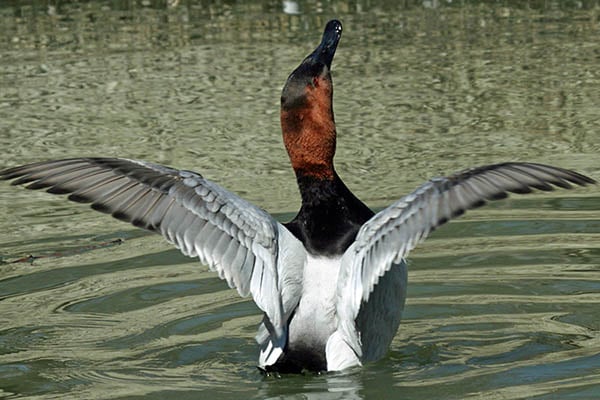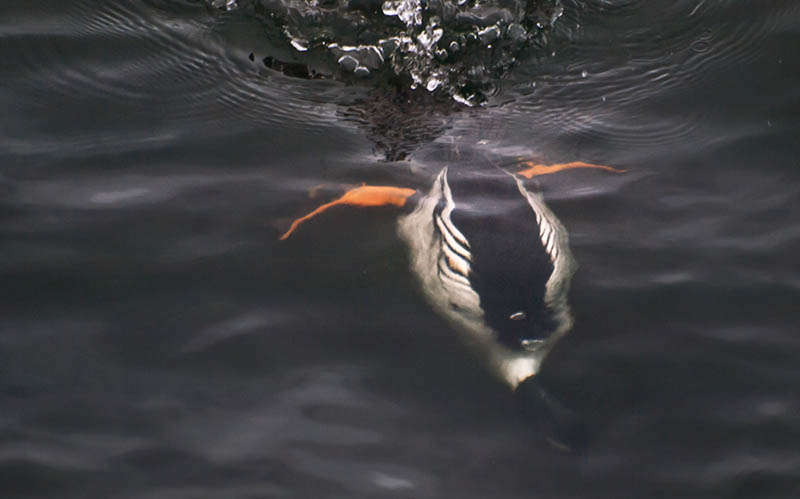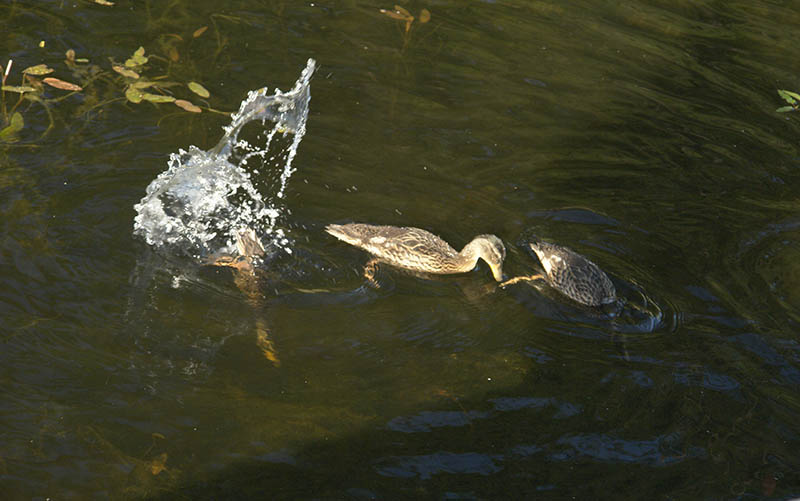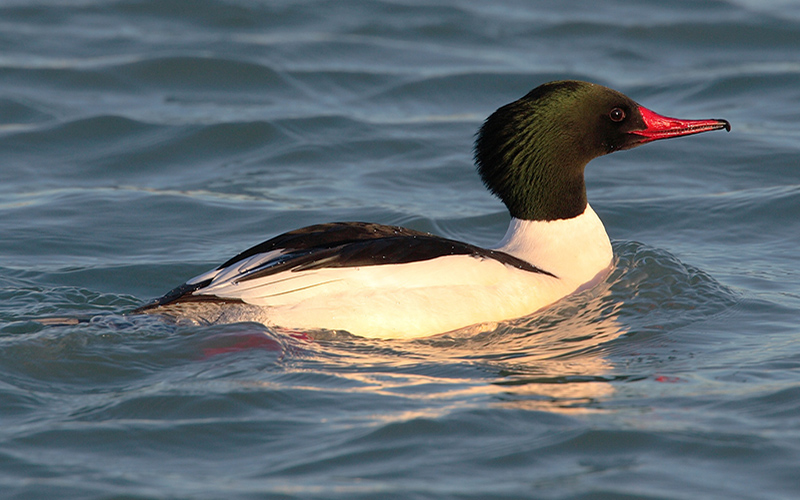
Last Updated on
Diving ducks are highly-adapted birds that specialize in foraging for food below the water’s surface. Hunting them successfully depends on your knowledge of their behaviors and the differences between the species.
Those of us who hunt diving ducks know the excitement of watching them rise and fall in rapid motions as they approach the decoys. In icy winds, below gray skies and over furious water, the divers drop their “landing gear,” hesitate and then burst in all directions at the moment they sense something is off. A flock of diving ducks is anything but subtle.
Although the “diver” label is extremely vague, there are three unique tribes of North American ducks that are commonly known as divers: stiff-tails (Ruddy Ducks), sea ducks (Mergansers, Scoters, Buffleheads, Long-tailed Ducks, Eiders, Harlequin Ducks and Goldeneyes), and pochards (Ring-necked Ducks, Redheads, Scaup and Canvasbacks). These waterfowl species have significant differences, but all share special physiological, behavioral and morphological adaptations for feeding and diving under the water’s surface.
Physical Differences of the Diving Duck
There are a few obvious physical characteristics that set diving ducks apart from their dabbling relatives. A diver’s body is wider in the middle, more tapered towards the end and generally more compact than a dabbling duck’s body. To gain better efficiency for maneuvering under the surface, diving ducks have more compact wings that can be tightly-compressed against the body. Diver’s feet are also much larger than dabblers and have a lobed hind-toe. These differences make it easier for divers to push themselves through the water.
How Divers Dive
In order to float on the water’s surface, most waterfowl are lighter than water. However, a diver’s body density is typically higher than other birds. Before diving, they compress their feathers against their bodies to squeeze out remaining air and decrease buoyancy. Then, diving ducks arch their bodies, dive headfirst and thrust their powerful legs to disappear under the water.
Once beneath the surface, they use both their feet and their wings to move downward to feed. During the descent, they shift their head and tail positions to steer. At the bottom, divers maintain a hover-like position using their feet while the forage for insects, mollusks, roots, tubers, seeds and other vegetation. These birds will dive to feed during all times of day and night.
Diving Ducks – Common Species
Among the three distinct tribes of diving ducks, each species and group has its own unique characteristics that set them apart. You will only see a few different types of diving ducks on any one hunt, and those types greatly depend on both the region and style of hunting you prefer.
The Pochards
Other than their ability to dive under the water, ducks in the pochard group have similar plumages. Typically, hens feature brown and gray plumages that contrast with the solid light and dark colorations of the males. Almost all male pochards also have striking eye colors such as yellow, red and orange. All pochards also make very similar sounds, with only minor variations following a common theme.
Canvasbacks
In the early days of duck hunting, canvasbacks were some of the most commonly-hunted species in North America. They were known for their delicious meat, and even featured in many high-end restaurants. In the late 1980s and early 1990s, canvasback populations dropped rapidly due to loss of habitat, over-hunting and lead poisoning. Now, their populations are rebounding and the hunting ban has been lifted in most areas.
Canvasback males have a distinctive chestnut-red neck and head with a black breast and grayish back. Their eyes are bright red during the spring season, but more dull in the winter. Hens have a pale brown head and neck that fades into a darker brown breast. Their back, sides and flanks are grayish-brown. Most canvasback ducks breed in the Prairie regions of North America, migrate through the Mississippi Flyway and winter in the Lower Mississippi Alluvial Valley and mid-Atlantic United States. Some families migrate over the Pacific flyway to wintering grounds along the California coast.
Redheads
Redheads are medium-sized ducks with red, rounded heads and a blue bill. Male redheads have brighter red neck and head plumage with black forebacks and breasts, while females have a more brownish-red head, neck and breast. Redheads breed throughout the northern prairies of the US and Canada. Females are notorious for laying eggs in other ducks’ nests. Most lay in other redhead nests, but some will lay eggs parasitically in the nests of canvasback and other duck species.
The most common migration path of redheads begins in Southwestern Manitoba and ends along the Gulf Coast. However, some of the population migrates east towards the Great Lakes and onward to the Chesapeake Bay and Florida. Approximately 80 percent of redheads in North America winter in the Laguna Madre region of Texas and Mexico.
Sea Ducks
Out of all the divers, the sea ducks are the most-accomplished. They can feed in water depths of up to 65 feet (most pochards and stiff-tails feed between two and ten feet of water depth). Long-tailed ducks can dive even deeper, reaching depths of up to 200 feet in unique scenarios.
Common Mergansers
The common merganser features a long and narrow bill with serrated edges that distinguishes it from all other duck species. Although the common merganser is one of the largest North American ducks, it is more streamlined than goldeneyes and eiders. They look more elongated in flight than other ducks and fly in close to the water’s surface.
Males have clean white bodies with dark green heads and slender, red bills. Females feature beautiful gray bodies and crested, cinnamon heads. Breeding grounds range from Alaska, Labrador and Newfoundland south towards California, Arizona and New Mexico and east to Minnesota, Michigan, New England and Nova Scotia. Common Mergansers have three primary migration routes: Newfoundland to Northern Florida, the Great Lakes to the Gulf of Mexico, and the Aleutian Islands to Mexico.
Buffleheads
Buffleheads are very small, buoyant, large-headed ducks. A large white patch extends from cheek to cheek across the back of the head on male buffleheads. The rest of the head is black with a purple and iridescent green sheen. Although the belly and sides of male buffleheads are clean white, the rest of their plumage is primarily black. Female buffleheads feature a brown heads and necks with an oval white patch below each eye. Dark grays, blacks and browns are found throughout the rest of the body and wings.
Bufflehead breeding grounds stretch from the heavily-forested areas of eastern Quebec to southern Alaska. These birds congregate on large lakes and major river systems until they freeze in the fall. After the freeze, buffleheads travel to the eastern United States, the Gulf of Mexico and along the Pacific Flyway. There are no particular areas known to be wintering grounds for Buffleheads; however, they can be found all along the coasts in the Gulf of Mexico, from Newfoundland to southern Florida and from the Aleutian Islands to Mazatlan.
Stiff-tails (Ruddy Ducks)
With small, compact bodies and oversized tails that they hold up in the air habitually, ruddy ducks stand out from the other divers. They have short, thick necks and stubby wings that also help identify them. Males have beautiful rusty-brown bodies with black heads and tails. A white patch extends around the throat and below the eyes. Males also have amazing sky blue bills. Female have grayish-brown plumage with a singly dusky stripe over a pale cheek patch. Unlike the males, female ruddy ducks have dark gray bills.
Most subspecies of ruddy ducks breed in the North American prairies and the Intermountain West. About 25 percent migrate to the East Coast for winter, and approximately 20 percent winter in the interior of North America.
Quick Hunting Tips
Since divers typically have heavier bodies than dabbling ducks, they generally have more difficulty taking off quickly from the water’s surface. While this can come in handy when ambush hunting, there are fewer possible ambush scenarios in typical diving duck habitats than there are in the small ponds where dabblers can be found.
The larger and heavier bodies of most diving ducks also means that you may need to take a look at your chokes and loads before heading out. It is essential to know what species you’re going after and to test your patterns before the hunt. An IC choke for example, may give you the tighter, more uniform pattern you need to bring down a diver.
As a diver hunter, you want plenty of white in your decoy spread to stand out against the dark, deeper water. However, you shouldn’t give up on your darker decoys, especially on bright days. Hens, redhead drakes and other dark-bodied decoys will show up well against the water on these days.
Gear and Equipment for Divers
There are many different ways to hunt diving ducks, but without the right equipment, none of them will get you very far. In basic terms, a lot of the same equipment used for dabblers can also be used for divers. However, there are some major differences to consider.
Decoys are just as important for hunting divers. Diver decoy spreads may need to be slightly larger, and choosing light and dark colored decoys that stand out above the water is also important. Decoy lines play a more significant role with diver spreads because there is often more distance to cover and current to deal with. Heavy-duty clips, drops, anchors and swivels should all be in your gear bag.
Diving ducks are well-known for their toughness, and they can get away very easily when crippled. Using tighter chokes and larger shot helps to diminish this problem. Size 3 and 2 shot is fairly common among diving duck hunters, but BB may be needed to finish off a cripple. It is essential that you are familiar with the pattern created by your gun, shot, and choke combination so that you can call the shot at the right time.
Duck calls are also just as critical for hunting divers as they are with dabblers, you may just need a different set for mimicking the different sounds that Canvasbacks, Redheads and other divers make. A boat may also be an essential piece of equipment depending on your hunting area.









Leave a Reply